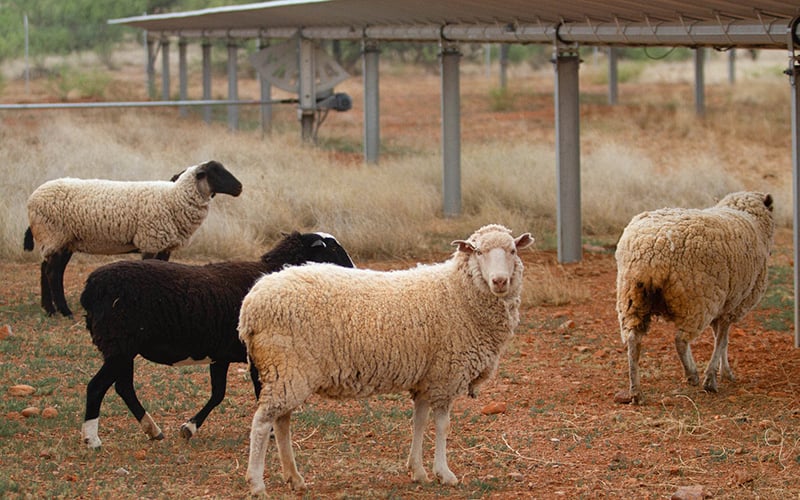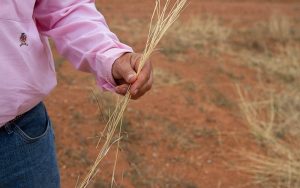
As four-legged lawnmowers, sheep are preferred over goats, which would eat wiring on the solar panels. (Photo by Tayler Brown/Cronkite News)
WILLCOX – It was time to bring the sheep in for a drink.
“Go to water, go to water!” shouts Rusty Cocke, who owns about 200 head of sheep that act as living lawn mowers on a solar farm about 20 miles west of Willcox.
The sheep have spent the morning munching through mesquite saplings and tall grass. They come in slowly, stepping among rows of solar panels that are harvesting the sun’s energy to power 20,000 Arizona homes.

Rusty Cocke herds his sheep to water after a day of munching grass around solar panels. (Photo by Tayler Brown/Cronkite News)
Once their water break is over, the sheep go back to work on the Red Horse II solar and wind farm, eating vegetation that could grow as high as 7 feet and cast shadows over the solar panels, decreasing their efficiency. The sheep essentially work for food and a place to stay.
Sheep, cows and goats are being used to clean up invasive vegetation on lands in Arizona and other states because, supporters say, it’s cheaper and environmentally friendlier than using machines. Cocke estimated his four-legged landscape operation is 30 percent cheaper than professional landscapers, which can cost $70,000 to $100,000.
Goats have grazed the grassy areas along Loop 202 in the southeast Valley, according to the East Valley Tribune. In Idaho, the federal Bureau of Land Management is researching whether cattle can graze in areas susceptible to wildfires. And there’s an Arizona website devoted to wildlife landscapers that touts the small carbon footprint of goats and the benefits of turning cattle into “weed managers.”
Machines, goats won’t work
The solar farm tried using people to mow the grass, said Eric Heim, who manages the Red Horse II and other solar and wind farms in the Southwest. But humans and their machines proved to be problematic.
The landscaping equipment was clunky and difficult to maneuver between the rows of solar panels, and it kicked up rocks and debris that could damage the solar arrays. The time investment was another issue.
“Before, it would take someone over 250 hours to mow the plants in between the panels every couple of months,” Heim said.
He considered using goats, but because goats will eat just about anything, they likely would chew the wires hanging underneath the solar panels. And cows are so big they’d rub against the panels.
Sheep solved the problem.

Shepherd Rusty Cocke rents out his sheep to clear vegetation growing around solar panels at Red Horse II solar and wind farm. (Photo by Tayler Brown/Cronkite News)
Cocke, the shepherd of the solar-farm herd, said sheep can handle most plants that nature provides. At the solar farm, Johnson grass, tumbleweed and mesquite trees can shade or overgrow panels if they’re not controlled.
At Red Horse II, which is owned and operated by a Houston company and contracts with Tucson Electric Power to provide renewable energy, the land tells the story of where the sheep have grazed. Red dirt is exposed, dotted with clumps of green near the panels. Elsewhere, golden sweeps of Johnson grass create a sea beneath some solar panels, awaiting hungry sheep.
“The sheep work perfectly symbiotic with the solar panels,” Cocke said. “They cruise through. They eat all the grass. I’ve had so much good luck with them right here.”
Cocke raises his sheep off the vegetation they eat at the farm and sells the sheep’s wool and meat for added profits. He would not say how much he was paid for the annual contract at Red Horse II.
Cocke wants to expand his sheep project into other ventures, perhaps even partnering with vineyards in southeastern Arizona.
Cattle prevent forest fires
Kathy Voth of Tucson, who runs the website Livestock for Landscapes and edits a weekly online magazine about agriculture practices, said livestock landscaping has been around for at least a decade. There’s little data on the practice, but she says it’s growing.

Johnson grass can grow 7 feet tall and impede solar-energy harvesting. (Photo by Tayler Brown/Cronkite News)
“Every year I get more and more emails about people interested in using animals for landscaping,” said Voth, who put together a handbook on CD, now out of print, with a cover photo of a goat clad in firefighting gear.
In Boise, Idaho, the Bureau of Land Management is researching the use of cattle for “targeted grazing” to reduce the severity and destruction of wildfires in the state, BLM spokesman David Walsh said.
The bureau considered cattle rather than sheep or goats because it feared those animals would spread disease to the vulnerable bighorn sheep population in the area, said Lake Okeson, the acting BLM field manager for the targeted-grazing project.
“This is the kind of stuff BLM should be doing all the time,” Okeson said.
The partnership is fantastic for local cattle owners to fulfill a need within the community and access extra grazing land, he said.
Voth said other commercial landscaping operations, such as Eco-Goats, which rents goats for landscaping in Maryland, have become more popular.
Voth’s website includes a database to connect people interested in goat landscaping with local shepherds who can provide the service.
This story is part of Elemental: Covering Sustainability, a new multimedia collaboration between Cronkite News, Arizona PBS, KJZZ, KPCC, Rocky Mountain PBS and PBS SoCal.
Subscribe to Cronkite News on YouTube.